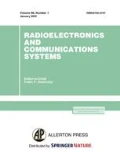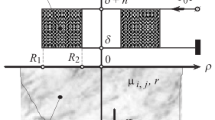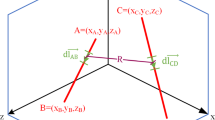Abstract
Changes in the geometric parameters of ring coils, which are an essential element of transducer design used for non-destructive testing of ferromagnetic metals, entail a change in the self-induction coefficient (inductance) of alternating magnetic field source. In the article, on the basis of proposed approach [1], the equations for determining the ring coils inductance are obtained, allowing to take into account real dimensions of inductors. They are equally suitable for situations where coil is located in an empty space, as well as near a conductive ferromagnetic or non-ferromagnetic metal. Calculating the inductance of ring coil located near magnetized, conductive ferromagnetic plate, we found that circuit inductance is the frequency-dependent complex-valued function vs distance between plate and ring coil. The measurements of the inductance of a coil located above a conductive ferromagnetic plate with a change in the non-contact value were carried out. The obtained results testify to physical meaningfulness and reliability of theoretical statements and calculations. These qualitative and quantitative results correspond to generally accepted energy definition of self-induction coefficient.









Similar content being viewed by others
References
O. N. Petrischev, M. I. Romanyuk, G. M. Suchkov, "Hankel transform application for calculation of ring coils inductance. Part 1," Radioelectron. Commun. Syst., v.63, n.5, p.235 (2020). DOI: https://doi.org/10.3103/S0735272720050027.
R. B. Thompson, "Physical principles of measurements with EMAT transducers," in Physical Acoustics (Academic Press, 1990). DOI: https://doi.org/10.1016/B978-0-12-477919-8.50010-8.
G. M. Suchkov, A. V. Donchenko, A. V. Desyatnichenko, A. A. Kelin, E. L. Nozdracheva, "Increasing the sensitivity of EMA devices," Russ. J. Nondestruct. Test., v.44, n.2, p.86 (2008). DOI: https://doi.org/10.1134/S1061830908020022.
S. Y. Plesnetsov, O. N. Petrishchev, R. P. Migushchenko, G. M. Suchkov, "Modeling of electromagnetic-acoustic conversion when excited torsional waves," Tekhnichna Elektrodynamika, v.2017, n.3, p.79 (2017). DOI: https://doi.org/10.15407/techned2017.03.079.
A. G. Gorbashova, O. M. Petrischev, M. I. Romanyuk, G. M. Suchkov, S. V. Haschina, "Investigation of the transfer characteristics of ultrasonic tract with electromagnetic excitation and detection of Rayleigh waves in ferromagnet. Part 1," Electron. Commun., v.0, n.2, p.69 (2013). URI: https://elibrary.ru/item.asp?id=21446152.
R. Ribichini, F. Cegla, P. B. Nagy, P. Cawley, "Study and comparison of different EMAT configurations for SH wave inspection," IEEE Trans. Ultrason. Ferroelectr. Freq. Control, v.58, n.12, p.2571 (2011). DOI: https://doi.org/10.1109/TUFFC.2011.2120.
M. Seher, P. Huthwaite, M. Lowe, P. Nagy, P. Cawley, "Numerical design optimization of an EMAT for A0 Lamb wave generation in steel plates," in AIP Conference Proceedings (American Institute of Physics Inc.). DOI: https://doi.org/10.1063/1.4864839.
H. M. Seung, C. Il Park, Y. Y. Kim, "An omnidirectional shear-horizontal guided wave EMAT for a metallic plate," Ultrasonics, v.69, p.58 (2016). DOI: https://doi.org/10.1016/j.ultras.2016.03.011.
D. Rueter, "Induction coil as a non-contacting ultrasound transmitter and detector: Modeling of magnetic fields for improving the performance," Ultrasonics, v.65, p.200 (2016). DOI: https://doi.org/10.1016/j.ultras.2015.10.003.
J. Isla, F. Cegla, "Optimization of the bias magnetic field of shear wave EMATs," IEEE Trans. Ultrason. Ferroelectr. Freq. Control, v.63, n.8, p.1148 (2016). DOI: https://doi.org/10.1109/TUFFC.2016.2558467.
J. He, K. Xu, W. Ren, "Designs for improving electromagnetic acoustic transducers’ excitation performance," Japanese J. Appl. Phys., v.57, n.6, p.067202 (2018). DOI: https://doi.org/10.7567/JJAP.57.067202.
P. L. Kalantarov, L. A. Zeitlin, Calculation of Inductances. Reference Book (Energoatomizdat, Leningrad, 1986).
I. E. Tamm, Fundamentals of Electricity Theory (Nauka, Moscow, 2003).
N. S. Koshlyakov, E. B. Gliner, M. M. Smirnov, Partial Differential Equations of Mathematical Physics (Vyssh. Shkola, Moscow, 1970).
Handbook of Mathematical Functions with Formulas, Graphs and Mathematical Tables (National Bureau of Standards, Gaithersburg, 1964).
V. I. Smirnov, Course of Higher Mathematics (BKhV-Peterburg, St. Petersburg, 2008).
Author information
Authors and Affiliations
Corresponding author
Ethics declarations
ADDITIONAL INFORMATION
O. N. Petrischev, M. I. Romanyuk, and G. M. Suchkov
The authors declare that they have no conflict of interest.
The initial version of this paper in Russian is published in the journal “Izvestiya Vysshikh Uchebnykh Zavedenii. Radioelektronika,” ISSN 2307-6011 (Online), ISSN 0021-3470 (Print) on the link http://radio.kpi.ua/article/view/S0021347020070018 with DOI: https://doi.org/10.20535/S0021347020070018
About this article
Cite this article
Petrischev, O.N., Romanyuk, M.I. & Suchkov, G.M. Hankel Transform Application for Calculation of Ring Coils Inductance. Part 2. Radioelectron.Commun.Syst. 63, 329–342 (2020). https://doi.org/10.3103/S0735272720070018
Received:
Revised:
Accepted:
Published:
Issue Date:
DOI: https://doi.org/10.3103/S0735272720070018




